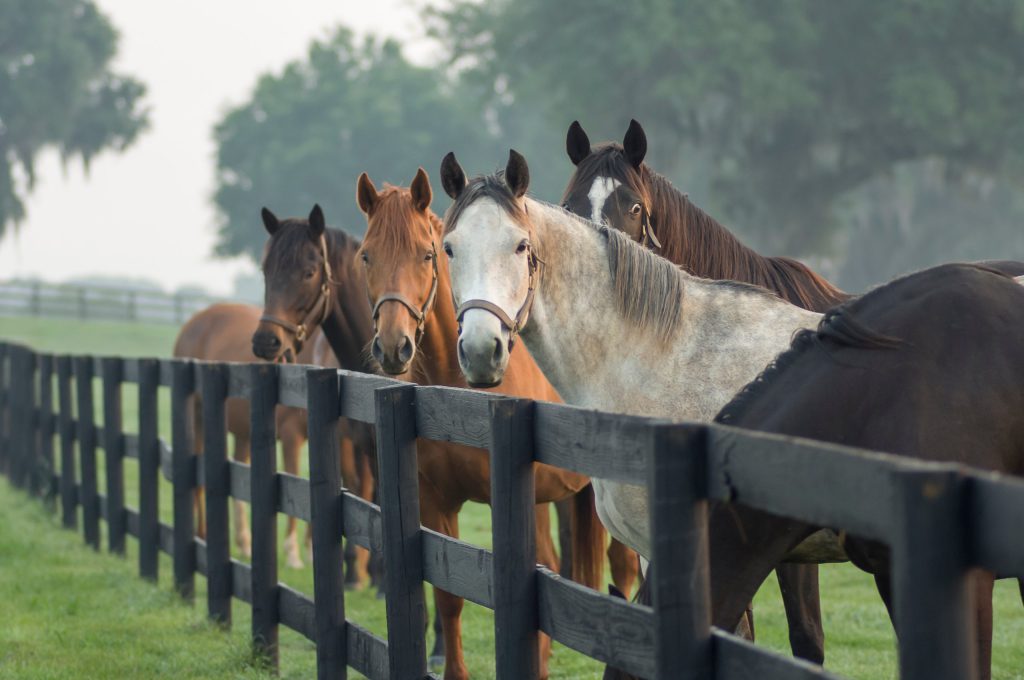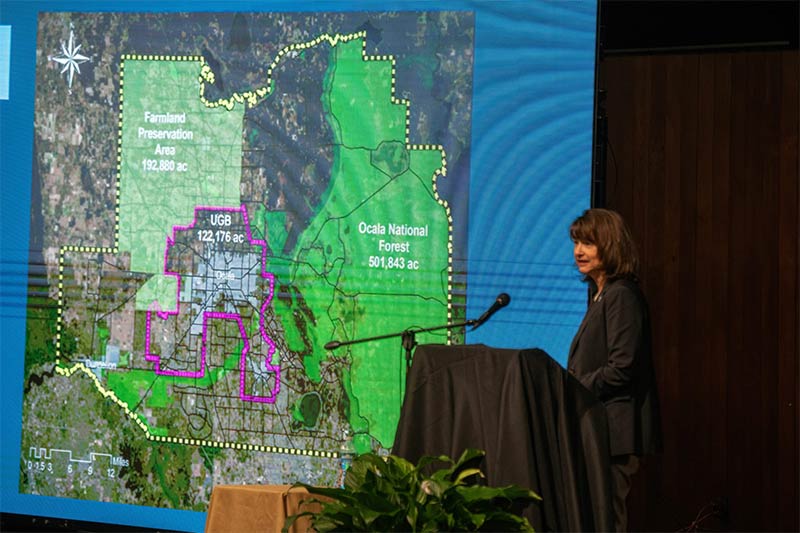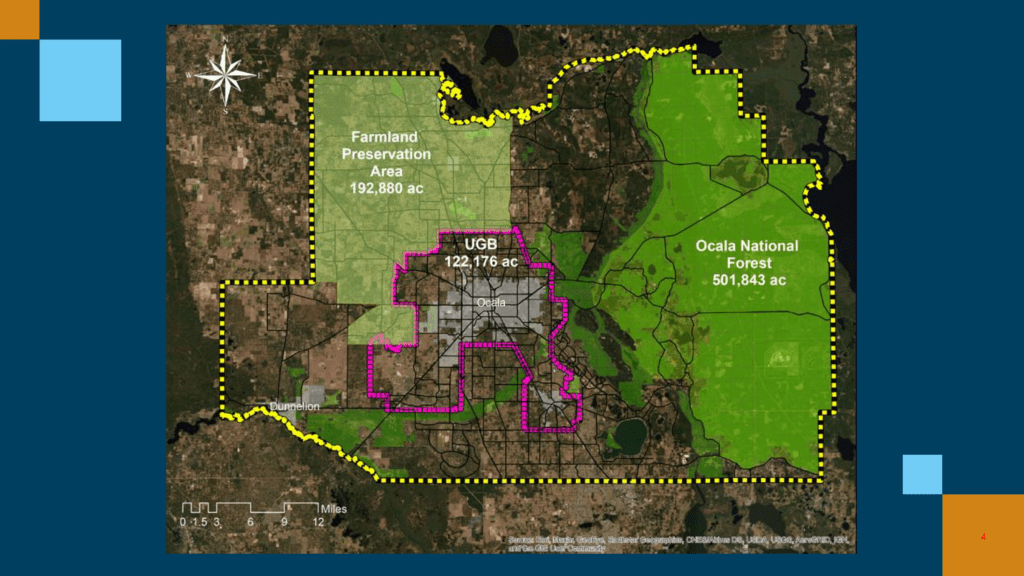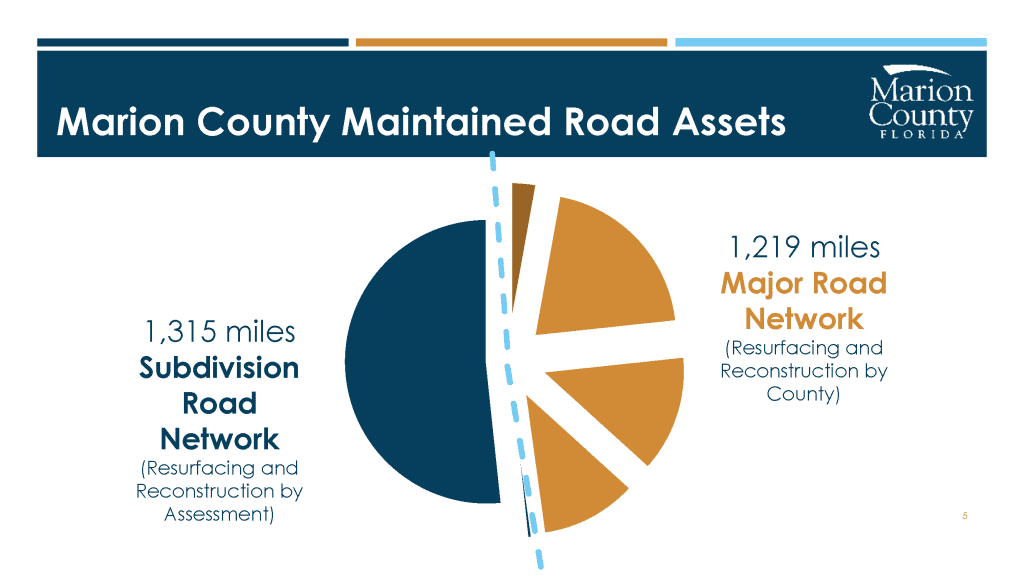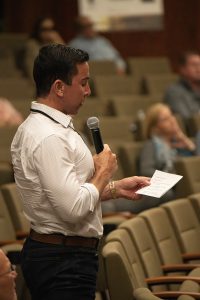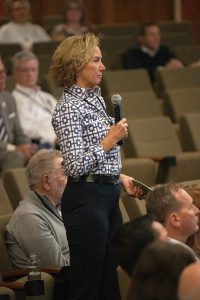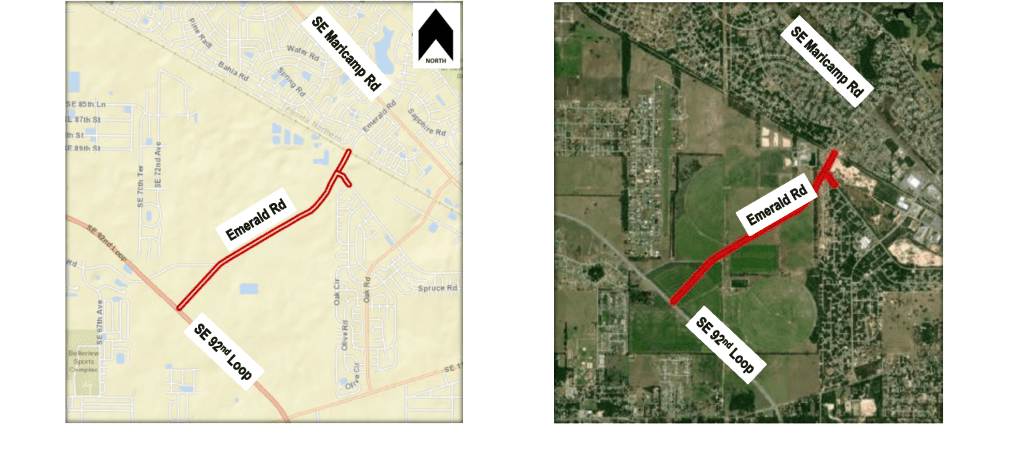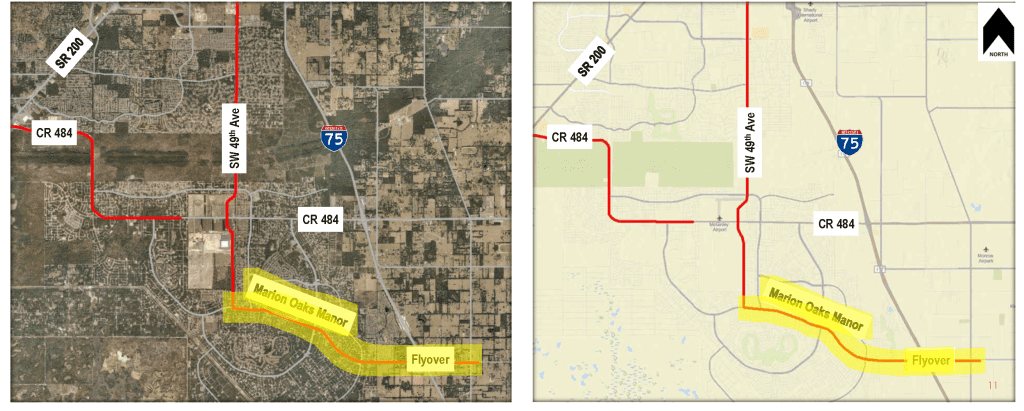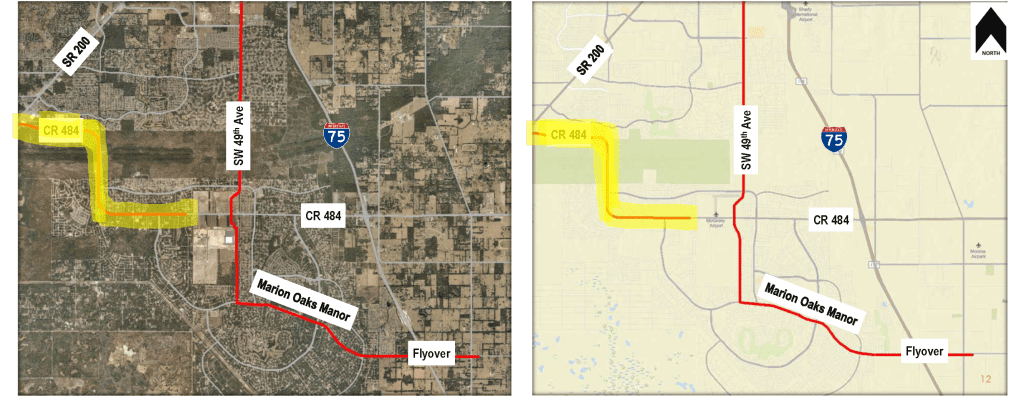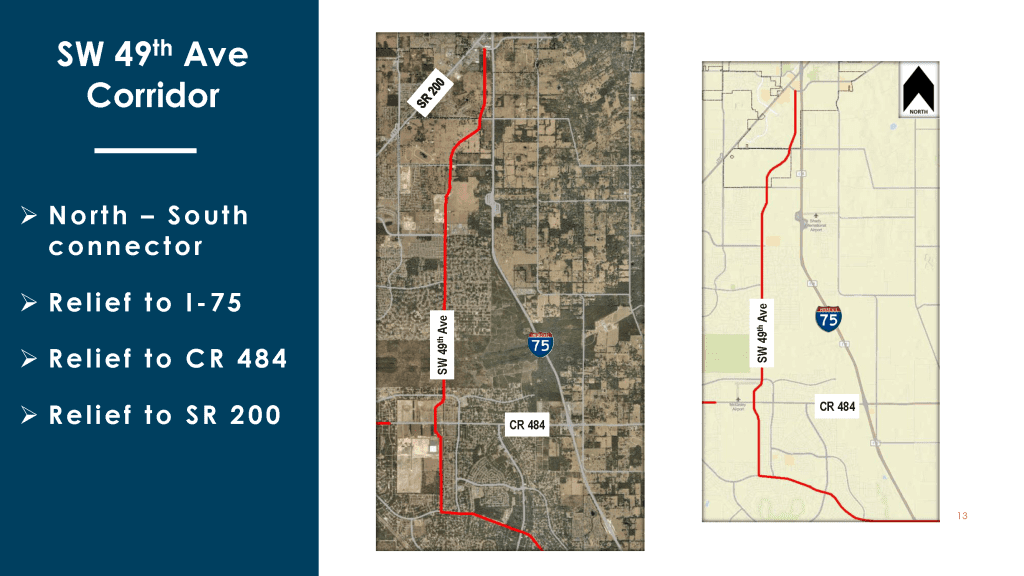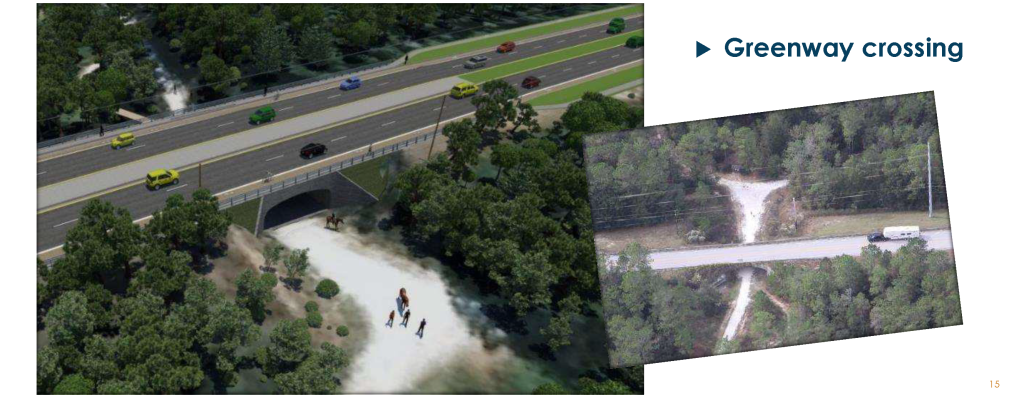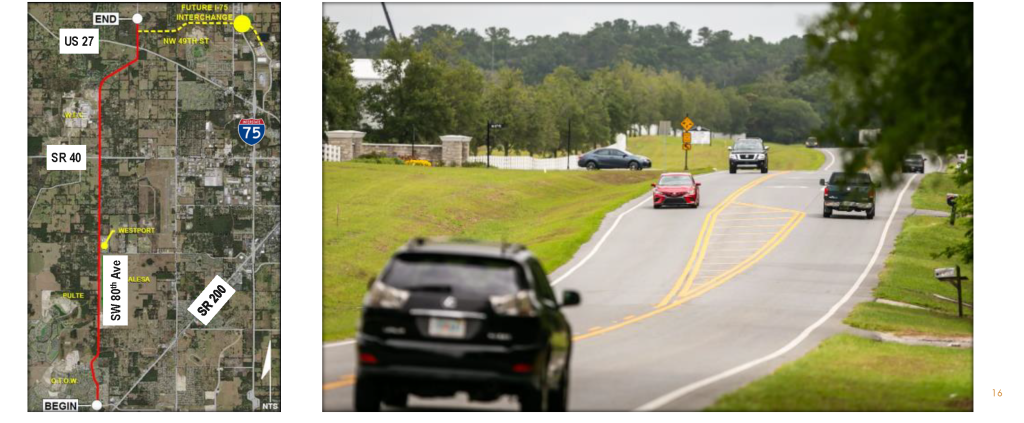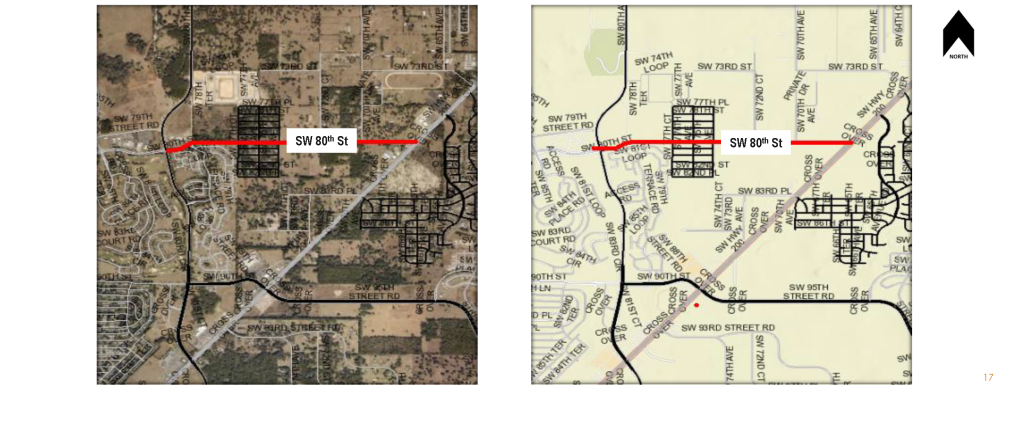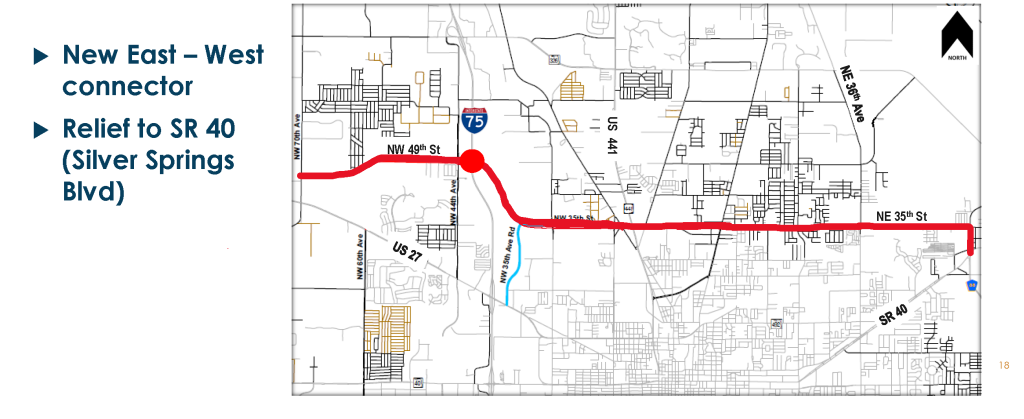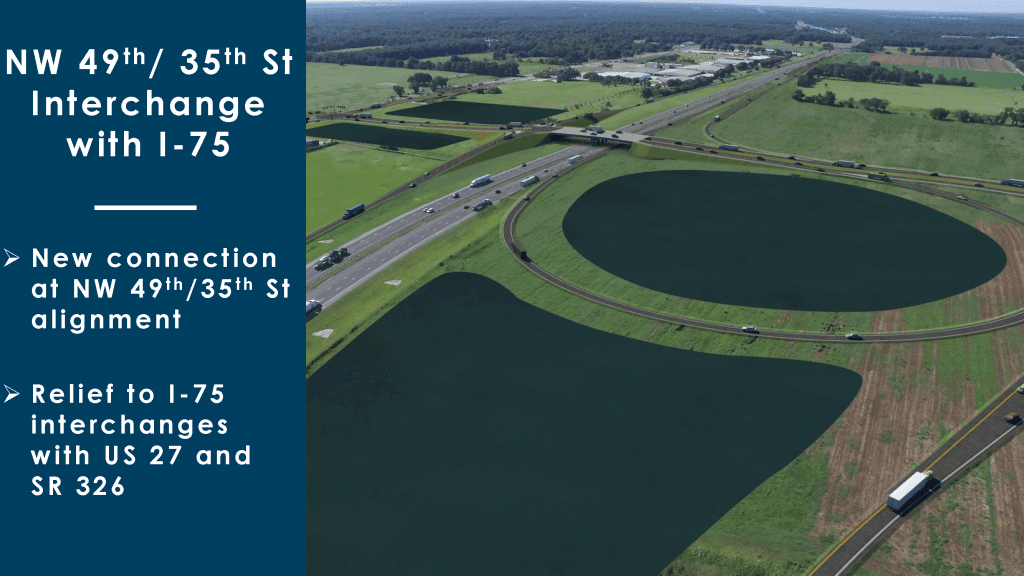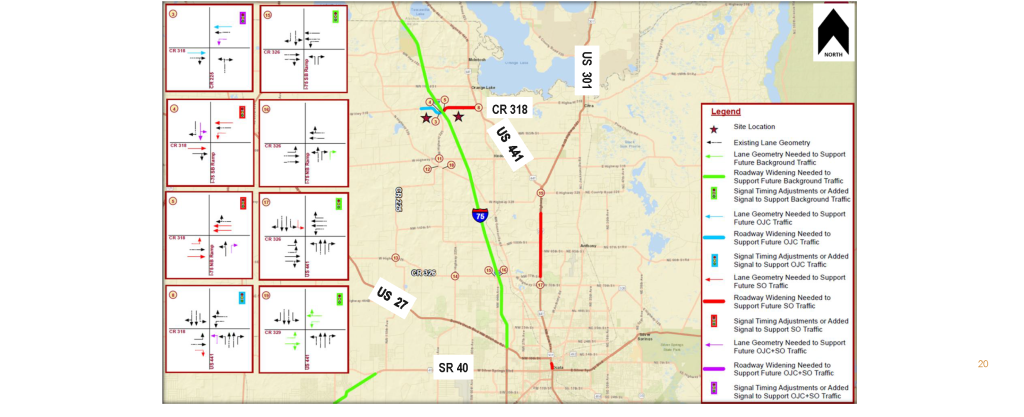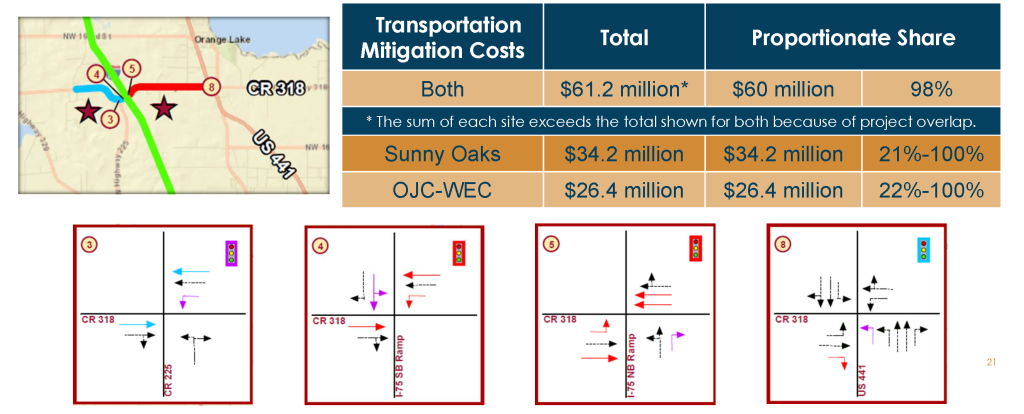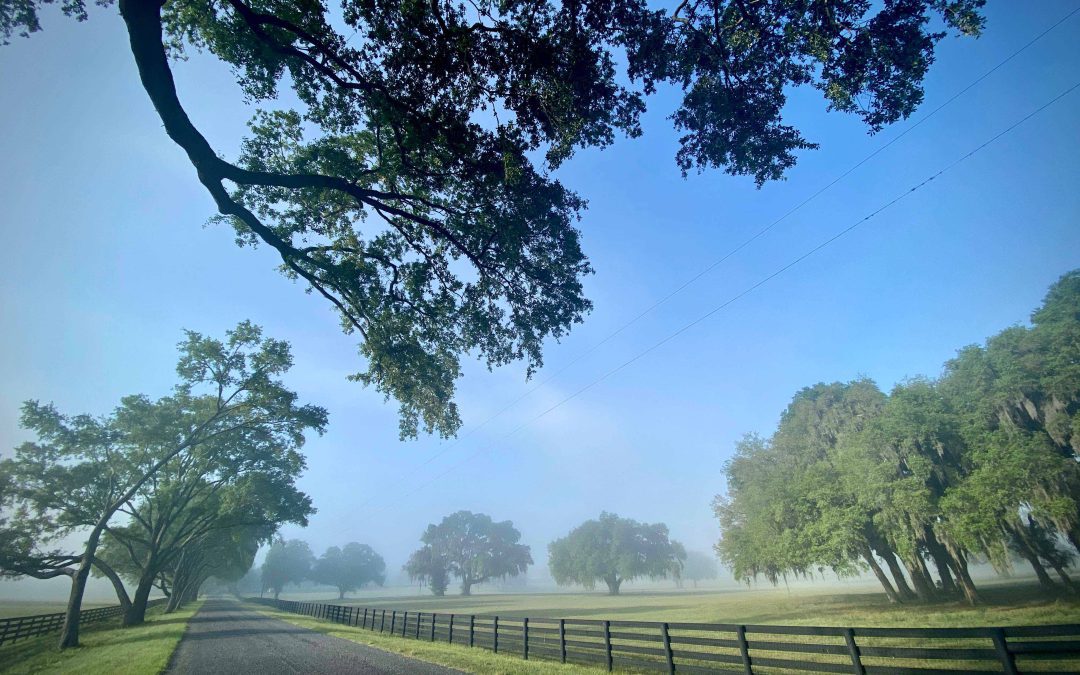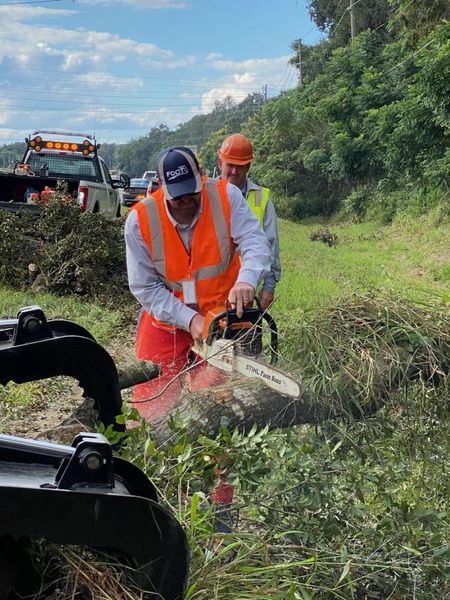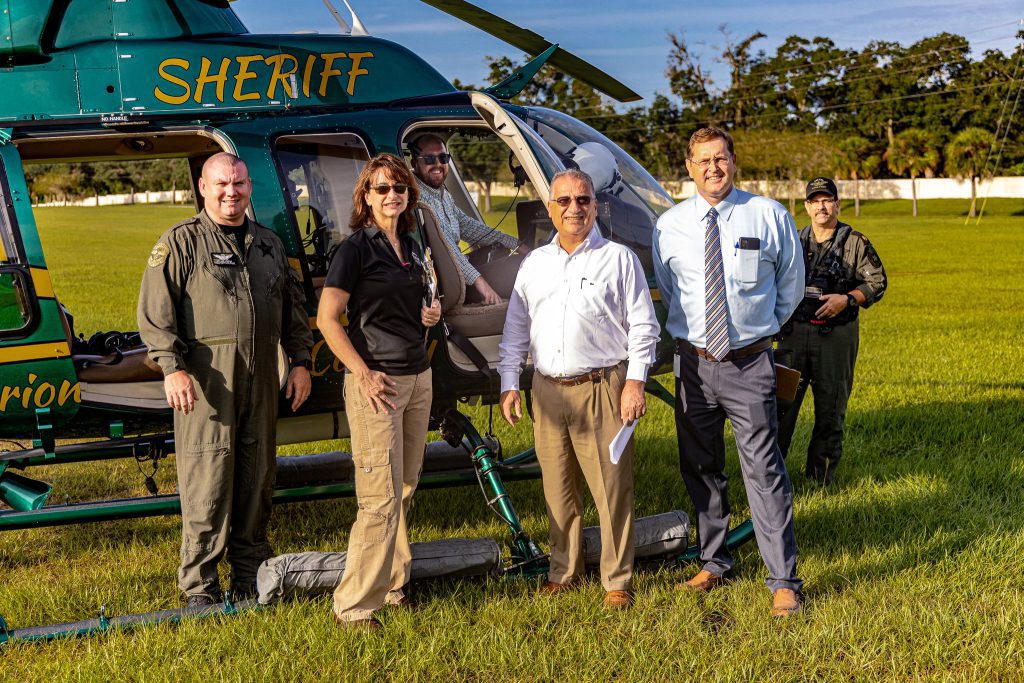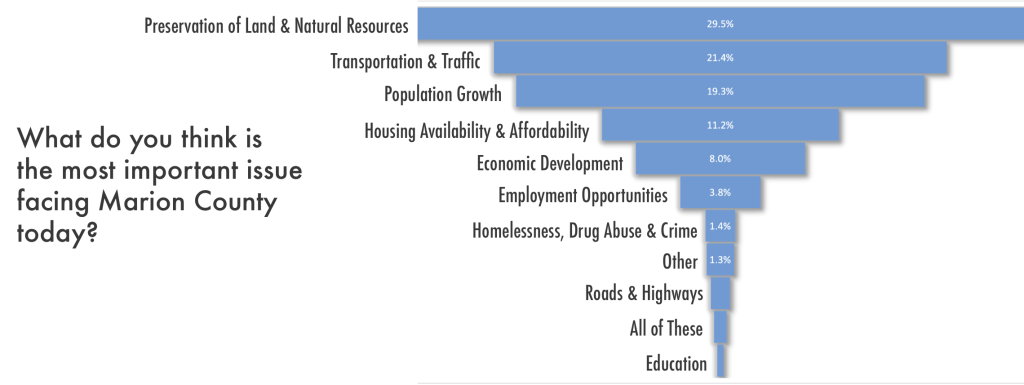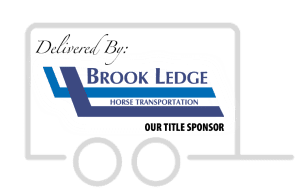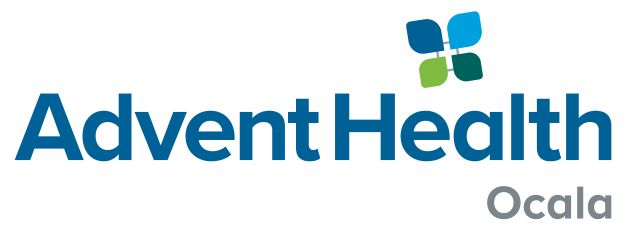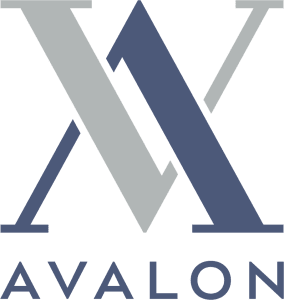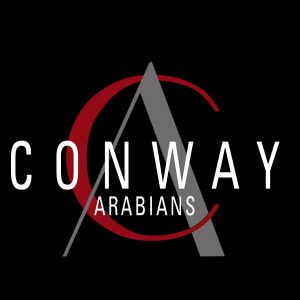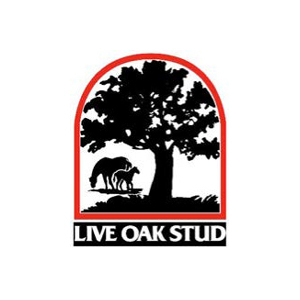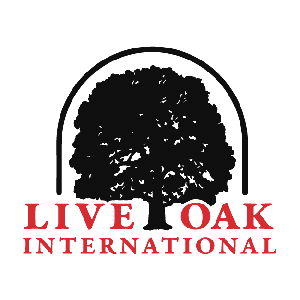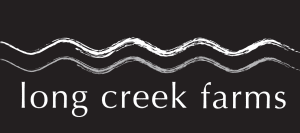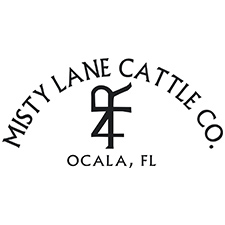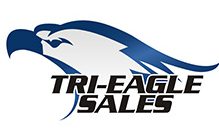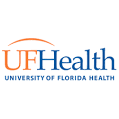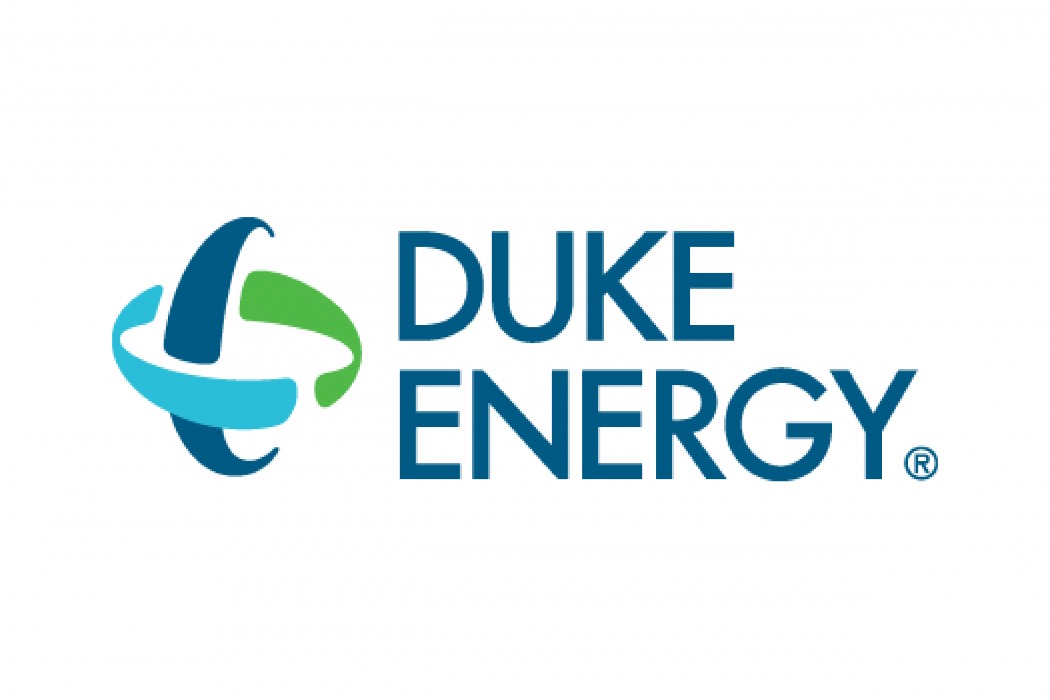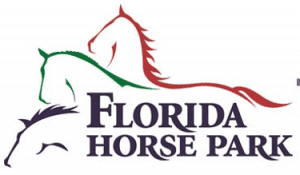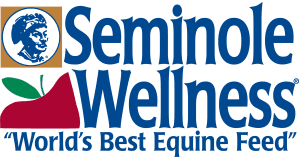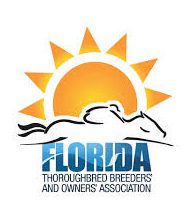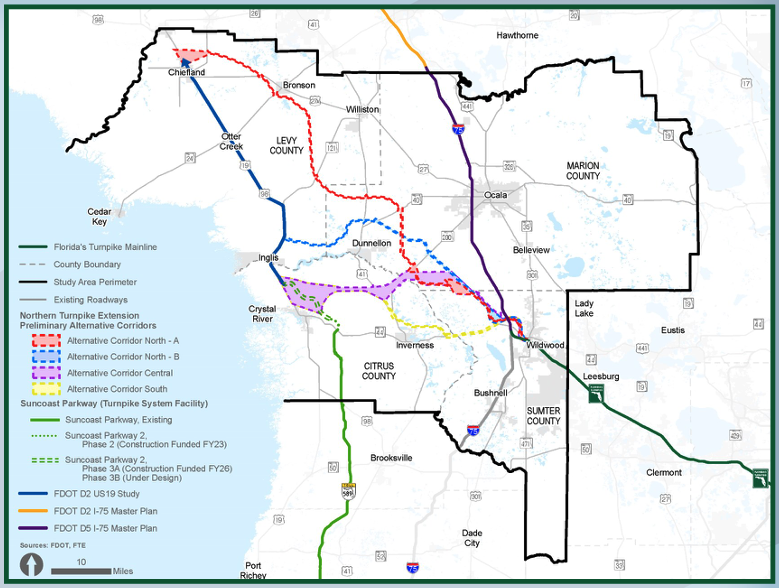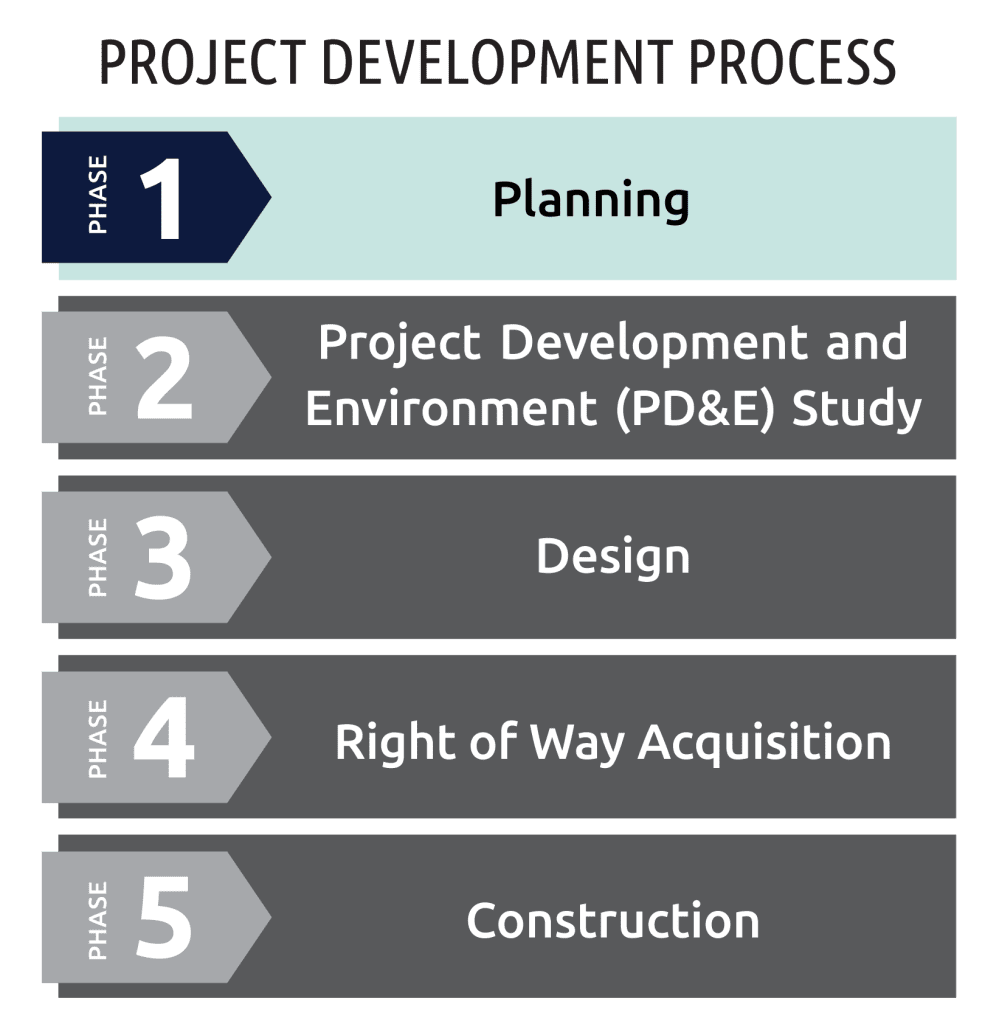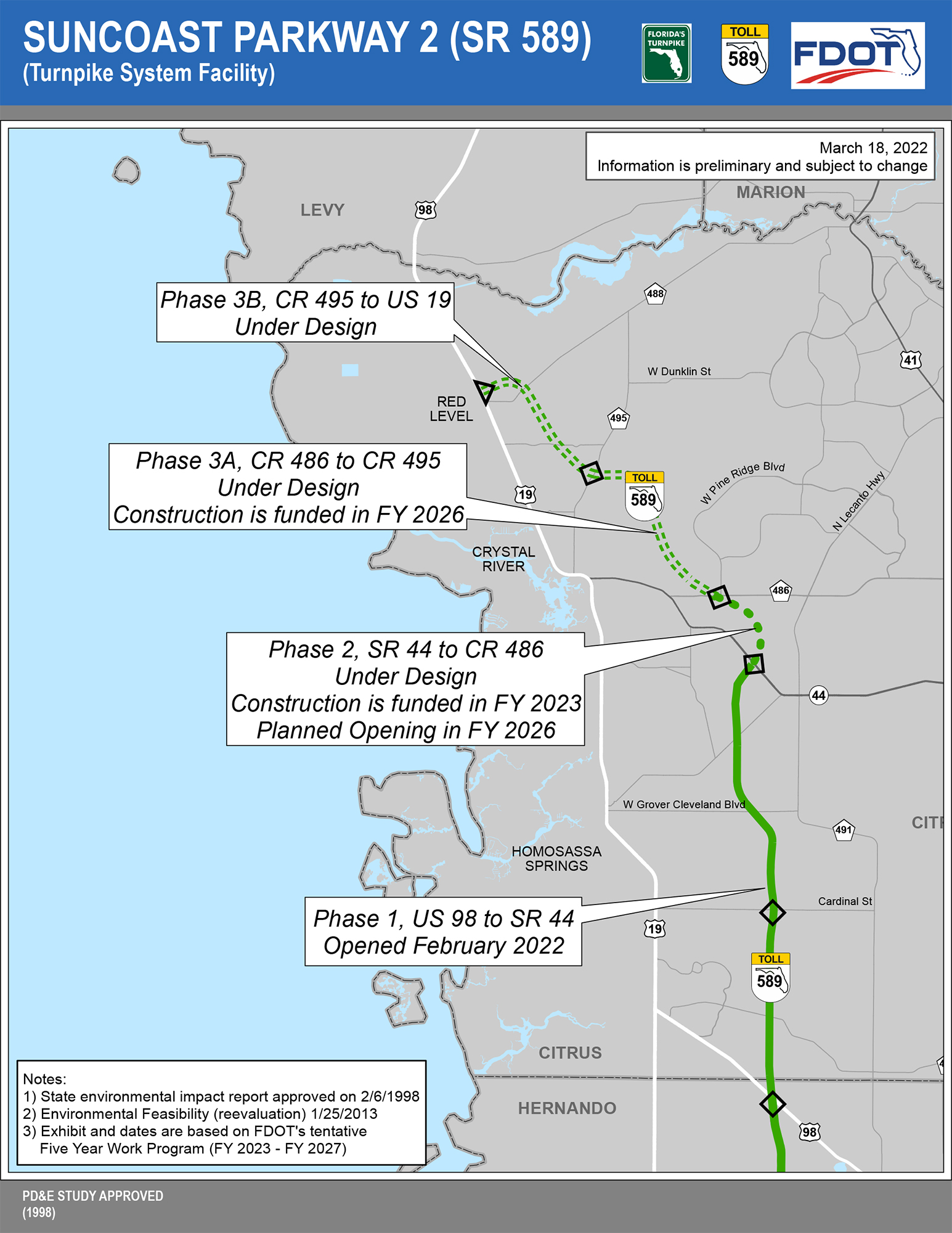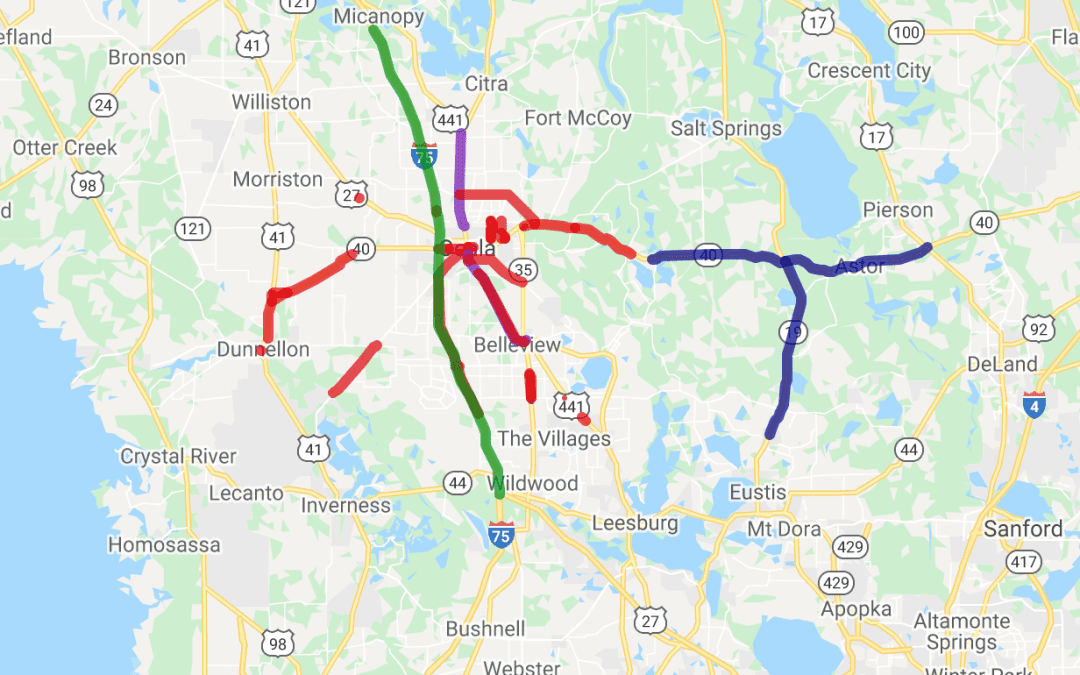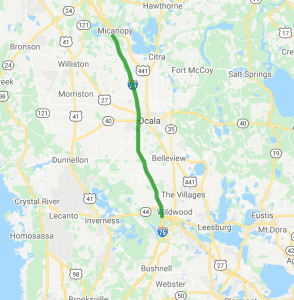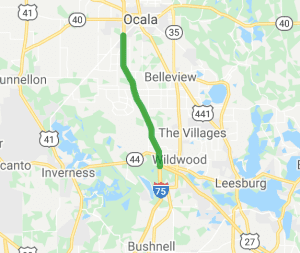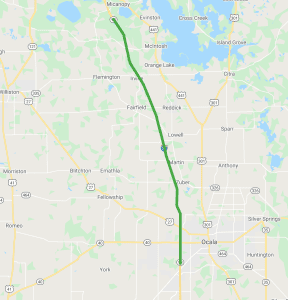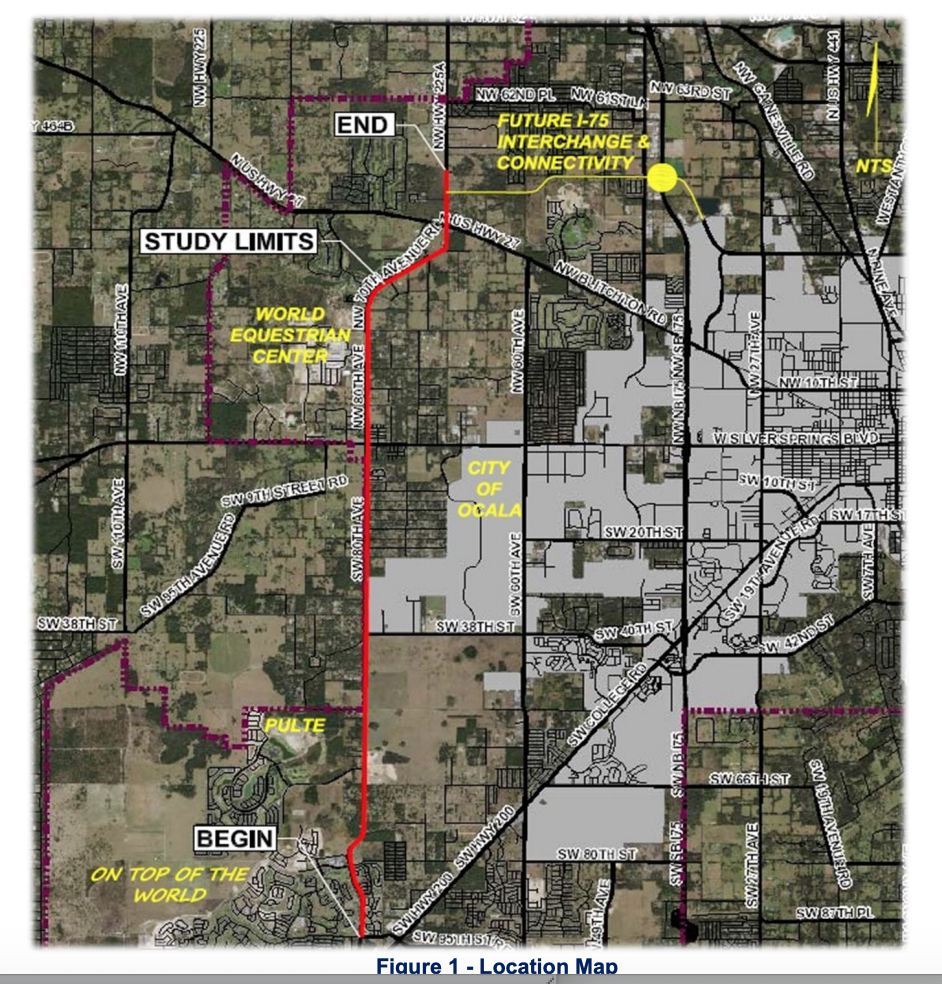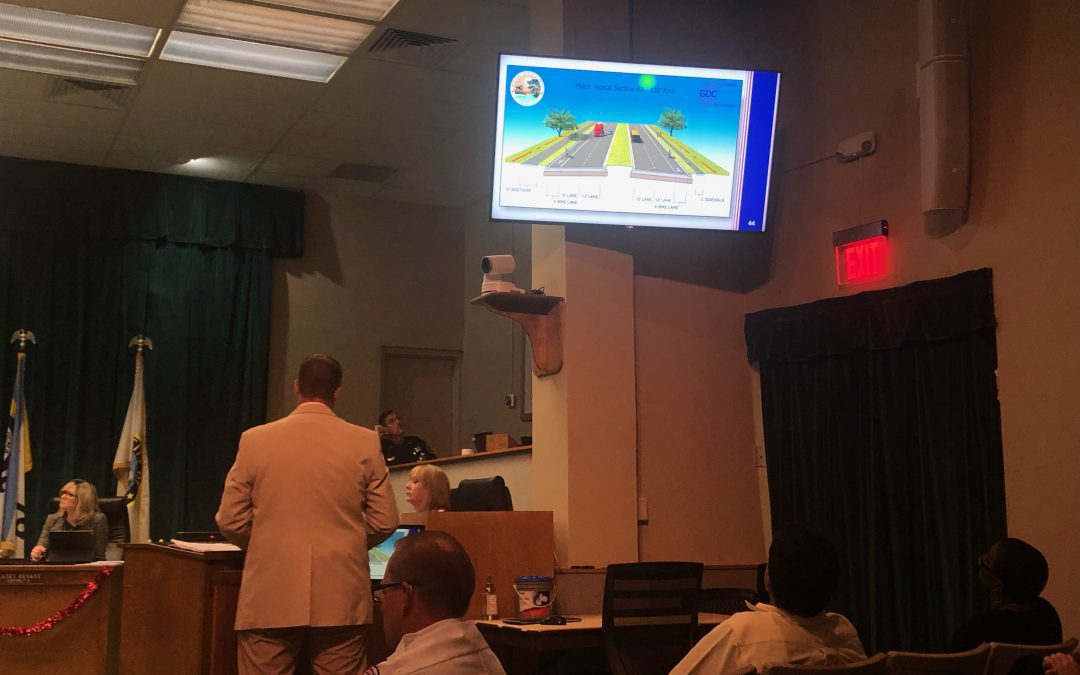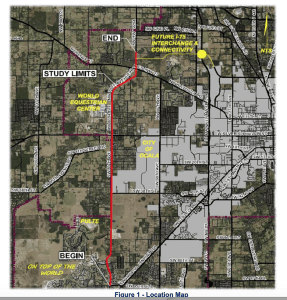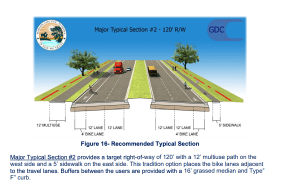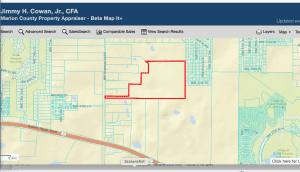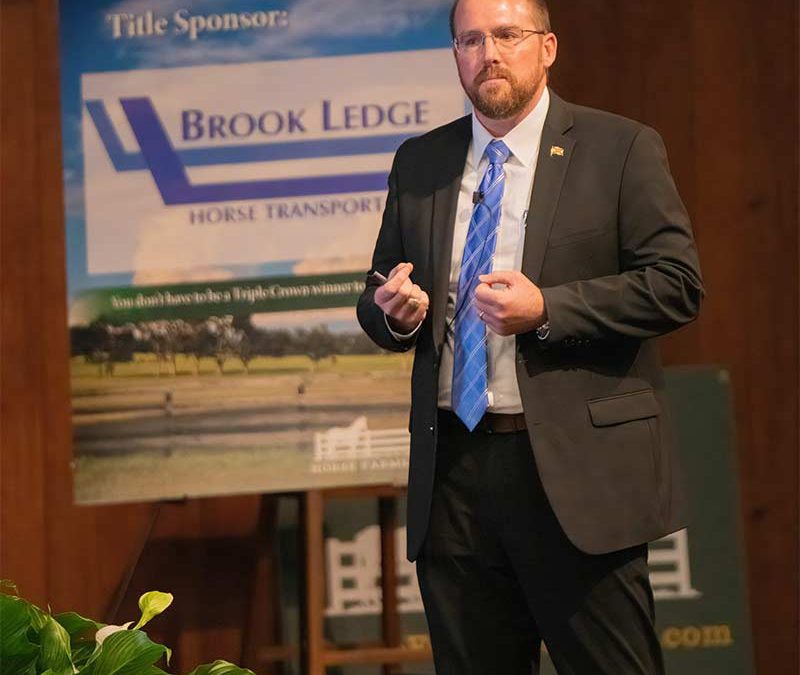
Perdue Emphasizes Community Engagement in Road Planning
What’s In Store For Marion County’s State-Owned Road Projects?
At Horse Farms Forever’s Conservation Summit on November 14, Jared Perdue, Secretary of the Florida Department of Transportation (FDOT) and Tracy Straub, Assistant Marion County Administrator, shared detailed information about Florida’s transportation approach and goals, and specific road improvement projects in Marion County. Secretary Perdue, who took over the post this past April, gave an update on the improvements to I-75 and the Northern Turnpike Extension project, which will resume in one to two years. He also emphasized FDOT’s new emphasis to recognize and protect the unique heritage and culture of Florida’s communities while at the same time improving road safety and efficiency.
The partnership between FDOT and Marion County was also highlighted as a vital component to completing nearly 42 road improvement projects that will widen and extend roads, build several flyovers, and a new interstate interchange at NW 49th Street. These projects will help divert traffic off of I-75 and allow residents to travel both north-south and east-west without having to access I-75. This blog will highlight important aspects of Secretary Perdue’s presentation. We will cover Administrator Straub’s in detail in the next release. To Summit livestream was recorded, and is available for viewing here.
Efficient Transportation Challenged By Astronomical Growth
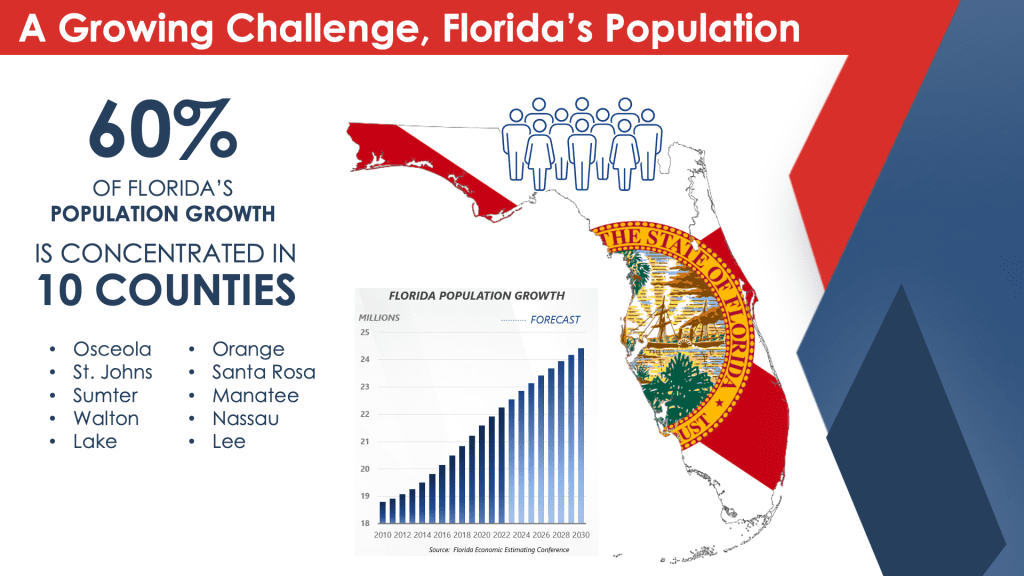
At the beginning of his talk, Secretary Perdue shared that the core FDOT mission is to provide safe and efficient transportation for the citizens of Florida, and to support the supply chain of goods and services. This is a challenge as Florida’s population continues to grow.
“This is one of the challenges with transportation – how do you provide necessary transportation, but still protect and conserve what makes Florida special,” said Secretary Perdue. “We have a unique challenge in Florida. We are the third most populous state in the union. We are growing rapidly, exponentially. Sixty percent of our growth is concentrated in 10 Counties: Osceola, St. Johns, Sumter, Walton, Lake, Orange, Santa Rosa, Manatee, Nassau, and Lee.. A lot of areas in Florida are growing at 20 percent annually.” Perdue shared that for every 100 people that move out of Marion County, 500 move in. “FDOT plans transportation projects based on a 3 percent population growth rate, and many areas of Florida are growing in excess of 20 percent, and so here’s what that means for an individual,” he said. “Yesterday, you had a 30-minute commute to work. It’s almost like you went to bed and woke up the next morning and all of a sudden, you’re sitting in traffic for an hour and a half trying to get back and forth to work.”
Transportation systems typically take 15 to 20 years to complete because of limited and finite resources that have to be spread across a very large state. FDOT must focus on a long timeline – planning for growth two decades in the future while maintaining enough capacity to handle emergency situations, like the recent devastation from Hurricane Ian. This year’s FDOT budget of $12.6 Billion is the largest in history.
“The challenge is because those areas have been growing so fast, 20, 30, and some areas even 40 percent growth, and so here’s the challenge, how do we think about transportation infrastructure differently so that we can start to catch up strategically,” he added.
Northern Turnpike Extension Is Still In The Plans
Secretary Perdue answered the most pressing question about the proposed NTE project to extend Florida’s Turnpike from Wildwood to U.S. 19 in Levy County. The NTE project was paused earlier this year, but Perdue confirmed that it was still in FDOT’s plans. The time frame has not been determined, but work on the proposed NTE project will start within the next one to two years. The project was paused due to the overwhelming negative feedback about the proposed routes from the communities in its path. FDOT’s response was to hit the pause button.
“Yes, we hear you, we don’t want to put a road through the heart of your community,” he said. “But we know we have to do something so let’s step back, let’s reengage with our communities and let’s talk about what those right solutions are because we know we need something.”
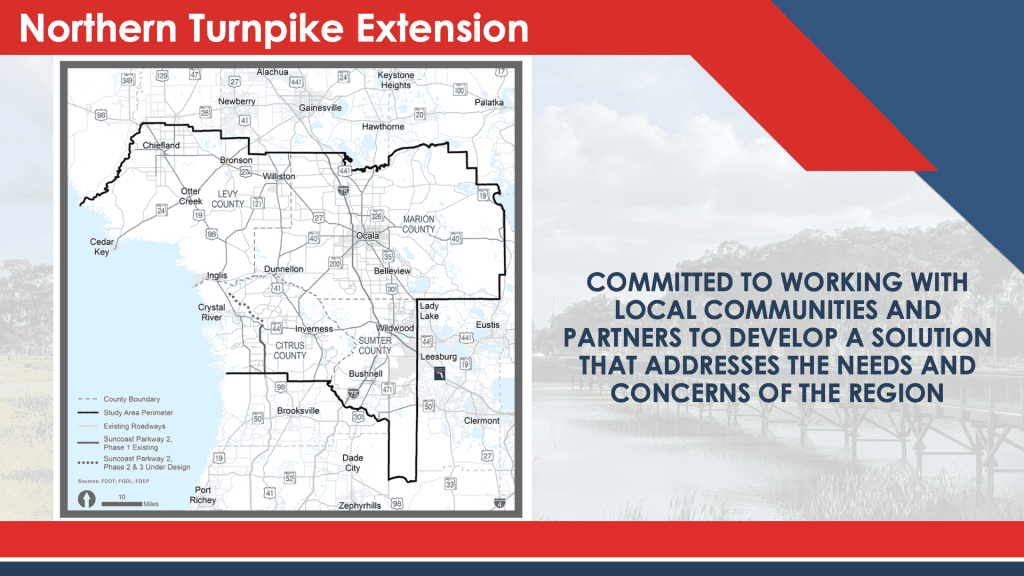
Perdue said the Northern Extension will connect to I-75 because it fits together as part of a bigger picture of how to solve the transportation challenges; because Florida is going to continue to grow and people and goods and services need to get from point A to point B. The NTE is also important for the future in terms of resiliency, hurricane evacuations, and natural disasters.
“We know we need to do something,’’ he said. “We want that something to preserve your farmland, to fit the growth patterns that are occurring. We want that something to continue to provide the needed transportation while embracing and maintaining the character of your community. And we believe that there’s a way to do that.”
A Love For Rural Florida
“I love the idea of protecting horse farms. I love horses and owned them myself,” he said. “I love Marion County and I love rural Florida. I was born and raised in rural Florida, so it’s really important to me.”
Secretary Perdue emphasized FDOT’s value on relationships with local governments and the goal to embrace and protect the character of communities.
“The reality is that anytime we set out to do something important, the way that people feel and that way that we engage them matters. It is absolutely critical for the future success of transportation systems in Florida,” said Secretary Perdue. He also addressed preservation and conservation directly. “What does that mean for how we deliver transportation in the future?” asked Secretary Perdue. “We believe that in order to successfully deliver infrastructure for the future based on the way that society has changed, based on the way that the state of Florida is changing and growing and adapting, that the absolute number one priority is for transportation infrastructure to embrace communities.”
He described the diversity of Florida and how important embracing this diversity is for transportation projects. Each community has its own culture, heritage, traditions, and also its own vision for the future.
“We believe that enabling transportation infrastructure to be a part of that heritage, a part of that tradition, but also a part of that vision for the future is where success is in transportation infrastructure,” he said. “This has become an umbrella focus for us. We believe that every single transportation infrastructure project can truly embrace the community that it lies within.”
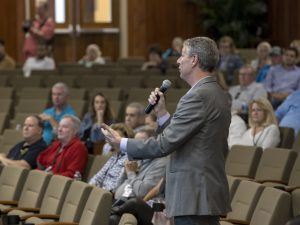
Question from Kevin Sheilley of the Ocala Metro CEP
QUESTION:
Two recent hurricanes came through Florida, 1 hitting the southwest coast and another the southeast coast.
- How did the interstate system handle the evacuation routes from the coastal areas?
- And, does there need to be a connection between the Suncoast Parkway and I-75 to enhance evacuations?
ANSWER By Secretary Perdue:
“There are a lot of complexities that go into evacuations, depending on where the storm is going, how much time people have to make decisions and what available routes there are. Depending on where the storm hits in Florida the plan completely changes. With Hurricane Ian, the path was changing constantly. The forecast wasn’t set in stone and it changed at the last minute. People had hours to figure out what to do.
We have outfitted our interstate system with technology so that we can watch evacuation behavior in real time. In the case of Ian, we saw a lot of congestion on I-4 and I-75 in general – in particular those hot spots where traffic is always an issue. If the facility is not reliable in everyday life, how is it going to be reliable in an evacuation?
Did our facilities do well during the Hurricane. I would say the answer is yes. Everybody that decided to get out, got out. We opened the shoulder of the road to help with traffic flow, but those pinch points on I-4 and I-75 were still there.
We want to build facilities to be reliable and resilient. To do that, you have to not only relieve those problem areas that already exist, but also build out for future growth.
We believe that something is needed for evacuation between I-75 and the West Coast. We will have to work through that solution together.”
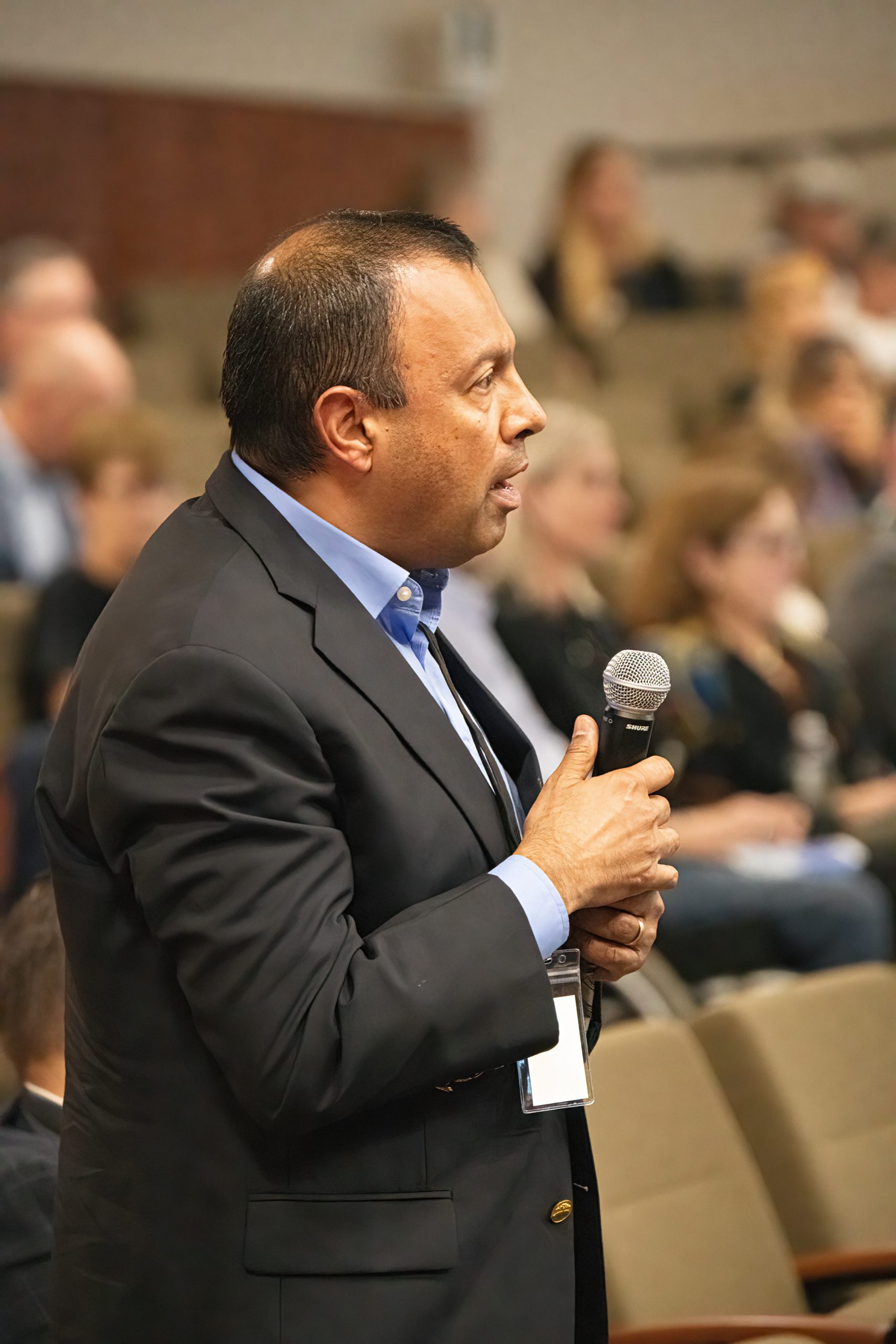
Question from Navroz Sanju of HDG Hotels
QUESTION:
We hear a lot about autopilots in cars and self-driving trucks.
- What is the future of self-driving cars and self-driving trucks on the interstate system?
- And is there any new technology you are including when you build a road to work with those systems?
ANSWER:
“Technology is one of our big strategic focus areas. Here in Florida we have 100 percent coverage of our Interstate System with the most current detection devices. We have the backbone in place for the future of autonomous driving vehicles. Technology changes so fast, and there’s been a lot of emotional speculation about what the future will look like.
We’ve developed new standards for these technologies to work. Artificial intelligence is always collecting data and using it to make decisions. Our infrastructure needs to facilitate that.
So, what’s realistic over the next ten to twenty years? First, there is tremendous efficiency to be gained on interstates using autonomous technology, such as the platooning of trucks. Our facilities must be upgraded for this future. We are already working on that. Autonomous vehicles can test and pilot on the Florida Interstate System. Second, what is really important is the ability of technology infrastructure to communicate important information to every day drivers – lane closures, stopped traffic, and accidents can be communicated to navigation apps by the road itself, helping drivers to make decisions.
We recently rolled out a pilot program that will allow every lane closure to be shared in real time with navigation apps.”
Early Feedback
Getting early feedback from communities is a new way of thinking for FDOT, but Secretary Perdue said that it’s “been hugely successful. Sitting down with communities before we decide what’s going to be done on that project to ask you: Hey what do you want to see – What would you like the feel of this roadway to be – How would you like it to look – What type of things would you like to see incorporated to help it align with your community?”
He said one example of this approach is the Wekiva Parkway, which protected more land for conservation than it impacted.
“I’ll give an example in terms of preserving and conserving with transportation actually having a net positive impact on what Florida’s true character is with the Wekiva Parkway in central Florida,” said Secretary Perdue. “A lot of the Wekiva Parkway, that’s a new toll facility, utilized an existing road, State Road 46 for a lot of the way, and we had a net positive impact on the environment because we actually purchased more conservation land as part of the project than we impacted with the project itself.”
However, due to FDOT budget constraints, not all suggestions are possible, but, when FDOT engages communities early in the process, the community becomes part of the team.
“Then we together can implement infrastructure that takes on the character of the community that it lies within,” he said.
Improvements to I-75
FDOT is coordinating closely with Marion County on nearly 42 projects and one of the top priority projects is improving I-75. The traffic congestion is a capacity issue, but it’s also related to the surrounding road network and because the Florida Turnpike ends at I-75 just south of Marion County. The goal of the master plan is to enhance mobility, improve reliability, and safety. There are two phases to the project with phase one adding additional lanes in each direction between SR 44 and SR 326. Phase one also includes interim modifications of the SR 326 and SR 40 interchanges. Phase two is ongoing.
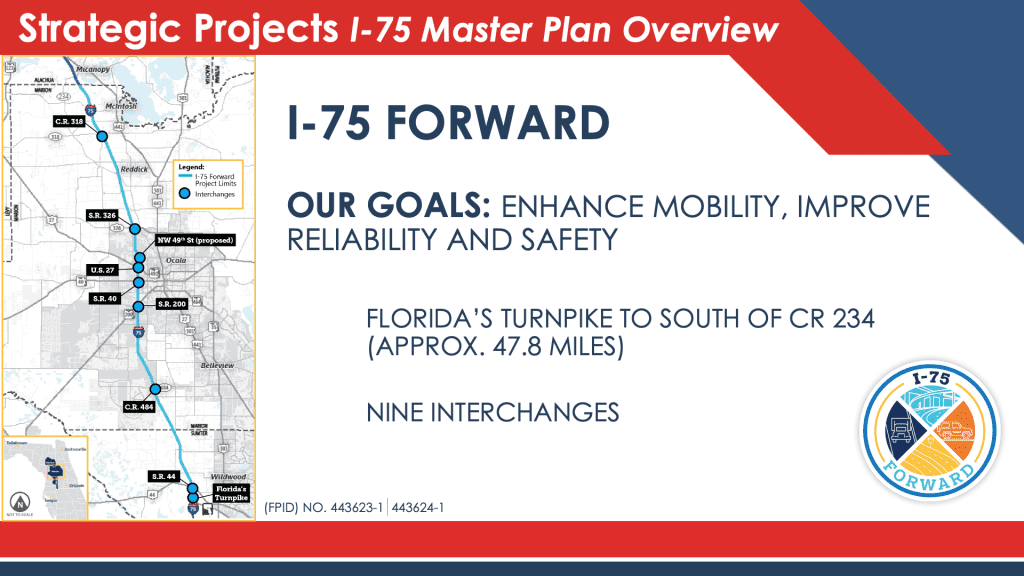
The I-75 Master Plan is also divided into two study areas. The Southern section is approximately 22.5 miles and it begins at Florida’s Turnpike, SR 91 in Sumter County and ends at SR 200 in Marion County. Interchanges to be evaluated include Florida’s Turnpike, SR 44, CR 484 and SR 200. The Northern section is approximately 25.3 miles and it begins north of SR 200 in Marion County and ends south of CR 234 in Alachua County. Interchanges to be evaluated include SR 40, U.S. 27, Northwest 49th Street (planned), SR 326, CR 318 and CR 234.
The Master Plan is to “identify improvement options for I-75 that we can affect quickly,” he said. “We don’t have 15 to 20 years. As a matter fact we need something there that should’ve been done probably 10 years ago based on how fast we are growing.”
The interstate must meet several different needs in Marion County including growing residential communities, heavy industrial development, and commercial development along the interstate. The challenge is to provide a facility for all of the different types of vehicles.
“This is a big conversation and it all works together but you don’t want to get lost in talking about what we need 20 or 30 years down the road when it needs it fixed today,” he said. “We’re looking at phase one and of what can we implement quickly and efficiently that will actually improve at a minimum the reliability of the roadway.”
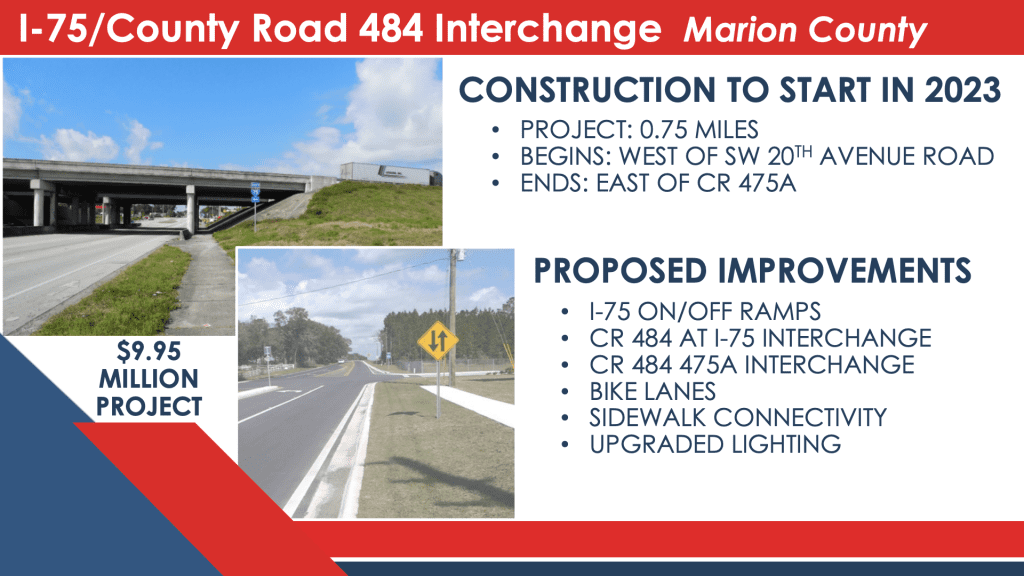
The I-75/CR 484 project is .75 miles and begins west of SW 20th Avenue Road and ends east of CR 475A. The improvements include on/off ramps, CR 484 at 1-75 interchange, CR 484/475A interchange, bike lanes, sidewalk connectivity, and improved lighting. The cost of this project is close to $10 million.

FDOT is partnering with Marion County to build a new interchange on I-75 at NW 49th Street. Marion County and FDOT are both providing the funds to build the new interchange, which is estimated to cost about $81 million.
“Marion County is absolutely a vital partner in transportation,” he said. “It’s truly a seamless partnership.”
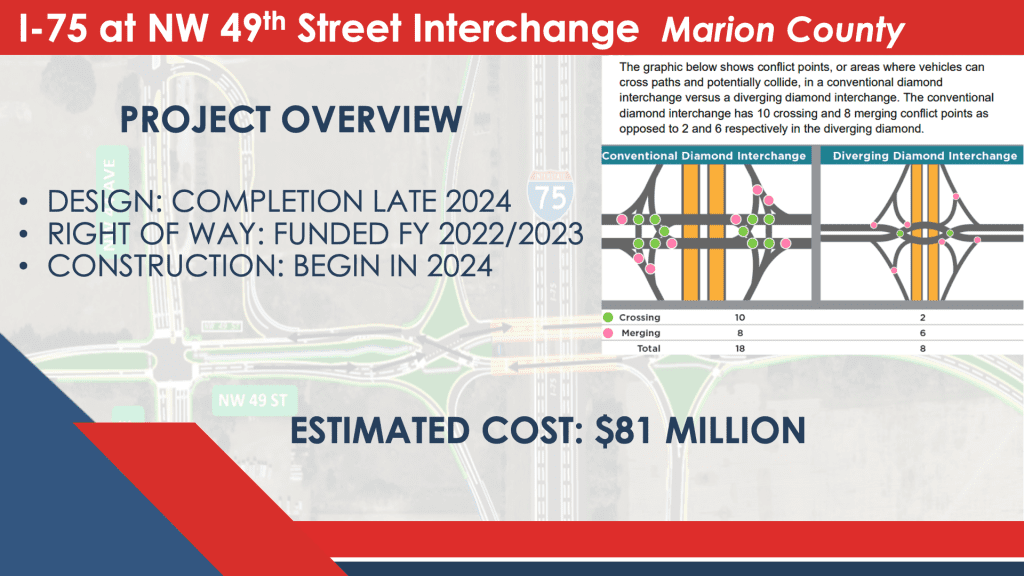
The new interchange is a Diverging Diamond Interchange (DDI) that will help improve interstate and regional mobility, accommodate future traffic growth and provide relief to existing surrounding interchanges. The right of way will be funded in 2022/2023 and the design will be completed in late 2024. The construction is expected to start in 2024.
The new interchange “is a broader picture of your how do you manage the system around that I-75 corridor and this is a going to help provide some of that connectivity,” said Secretary Perdue.
Next: Focus on County-Owned Projects
Tracy Straub, PE, Marion County Administrator, Public Works and Growth Services, also presented an update of the top road improvement projects including the area known as the Ocala Triangle, which includes State Road 200 and Southwest 60th and Southwest 80th Avenues. Straub gave an update on the CR 318 and I-75 Sunny Oaks/Irvine area. Our next blog will cover Administrator Straub’s presentation, including downloadable maps for the Marion County projects. Stay tuned!
Photos by Sean Dowie Photography. Remaining graphics provided by FDOT.
Watch the entire Summit presentation online:
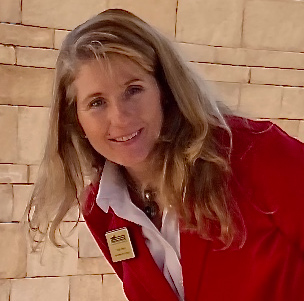
What About Zoning?
The Zoning regulations are found in the Land Development Code, which is a separate document with specific guidelines to implement the Goals, Objectives, and Policies of the Comprehensive Plan.
Zoning regulates development through land use classifications and specifies the areas in which residential, industrial, recreational or commercial activities may take place. The Land Development Code was adopted through a series of ordinances by the County Commission, which means that the regulations cannot be changed or waived, except by a further vote of the County Commission.
Contact the County about the EAR:
For any additional questions regarding the EAR process, please email Planning@MarionFL.org with your subject line including 'EAR' or call us at 352-438-2675 & ask for a planner.
The workshops will be livestreamed. Check the County’s agenda webpage for the link: https://marionfl.legistar.com/Calendar.aspx

